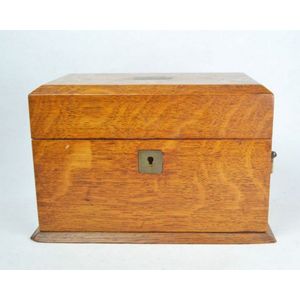Victorian Oak Tea Caddy with Gilt Handles
You must be a subscriber, and be logged in to view price and dealer details.
Subscribe Now to view actual auction price for this item
When you subscribe, you have the option of setting the currency in which to display prices to $Au, $US, $NZ or Stg.
- Victorian Period - The Victorian period of furniture and decorative arts design covers the reign of Queen Victoria from 1837 to 1901. There was not one dominant style of furniture in the Victorian period. Designers used and modified many historical styles such as Gothic, Tudor, Elizabethan, English Rococo, Neoclassical and others, although use of some styles, such as English Rococo and Gothic tended to dominate the furniture manufacture of the period.
The Victorian period was preceded by the Regency and William IV periods, and followed by the Edwardian period, named for Edward VII (1841 ? 1910) who was King of the United Kingdom and the British Dominions and Emperor of India for the brief period from 1901 until his death in 1910. - Oak - Native to Europe and England, oak has been used for joinery, furniture and building since the beginning of the medieval civilisation. It is a pale yellow in colour when freshly cut and darkens with age to a mid brown colour.
Oak as a furniture timber was superceded by walnut in the 17th century, and in the 18th century by mahogany,
Semi-fossilised bog oak is black in colour, and is found in peat bogs where the trees have fallen and been preserved from decay by the bog. It is used for jewellery and small carved trinkets.
Pollard oak is taken from an oak that has been regularly pollarded, that is the upper branches have been removed at the top of the trunk, result that new branches would appear, and over time the top would become ball-like. . When harvested and sawn, the timber displays a continuous surface of knotty circles. The timber was scarce and expensive and was used in more expensive pieces of furniture in the Regency and Victorian periods.
This item has been included into following indexes:
Visually similar items

A Rene Lalique Domremy vase, designed 1926, the baluster body moulded with a continuous pattern of overlapping thistles, in frosted and opalescent glass with a grey patina, inscribed R. Lalique France, 21.3 cm high. Provenance: King David Gallery, Tel Aviv

A pair of sterling silver sauce boats, 1915 Birmingham, with maker's marks for J.B Chatterley & Sons Ltd, the pedestal boats of typical form with elegant 'C' style handles and threaded spreading bases; hallmarked to upper body of each, silver weight 159gr.

George V hallmarked sterling silver ink well. Birmingham 1912, maker Su..., with ceramic ink receptacle. Dents to lid. Wt. 307g

Ivory netsuke, hand coloured and signed
